牛津译林版七年级下册 Unit 4 Period 3 Grammar课件(共71张PPT)
文档属性
| 名称 | 牛津译林版七年级下册 Unit 4 Period 3 Grammar课件(共71张PPT) | 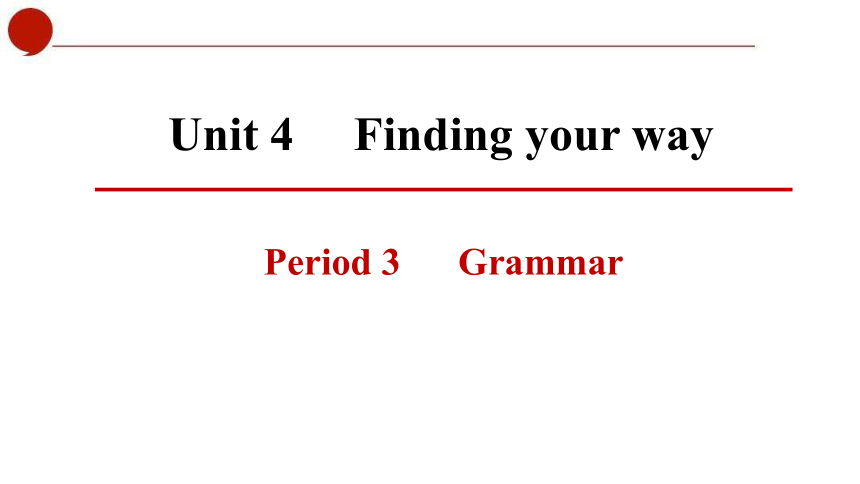 | |
| 格式 | ppt | ||
| 文件大小 | 36.7MB | ||
| 资源类型 | 教案 | ||
| 版本资源 | 牛津译林版 | ||
| 科目 | 英语 | ||
| 更新时间 | 2023-05-18 20:18:03 | ||
图片预览


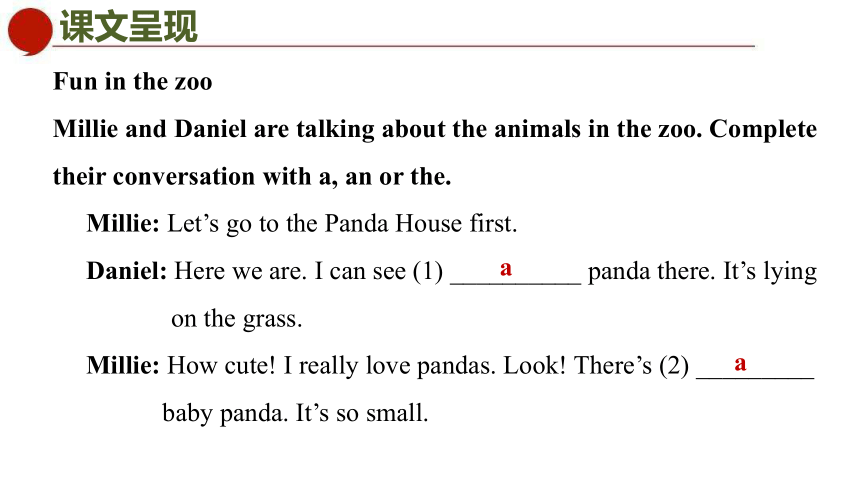
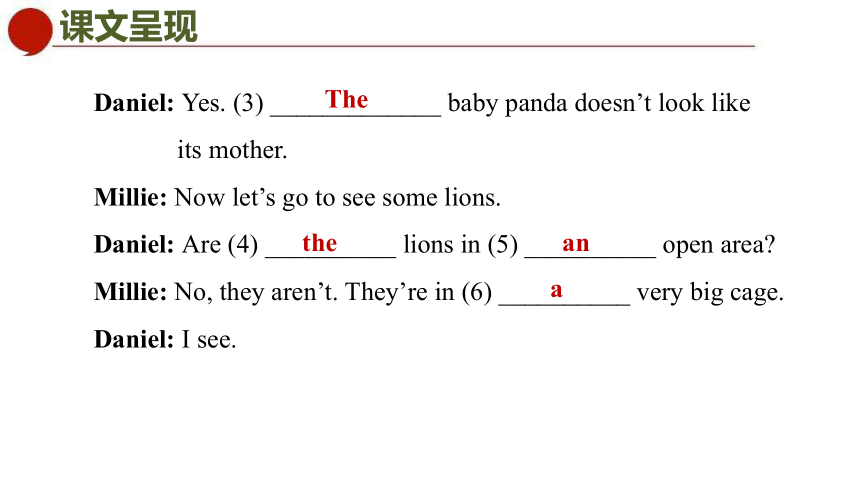


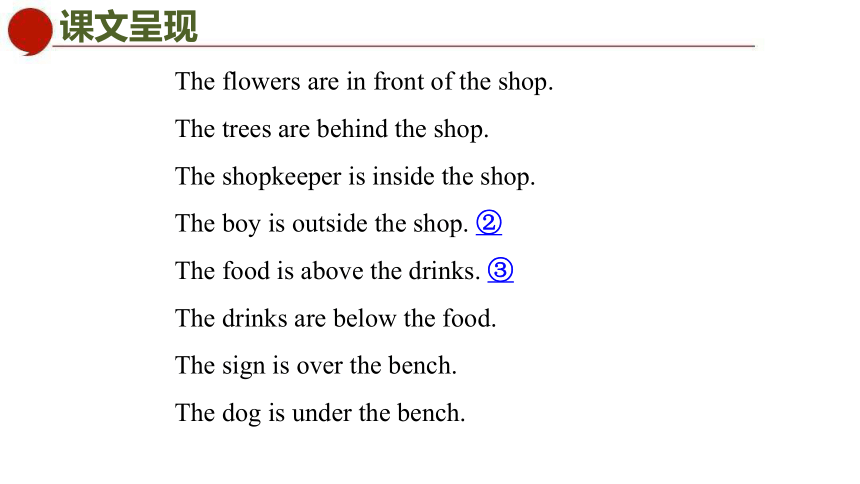

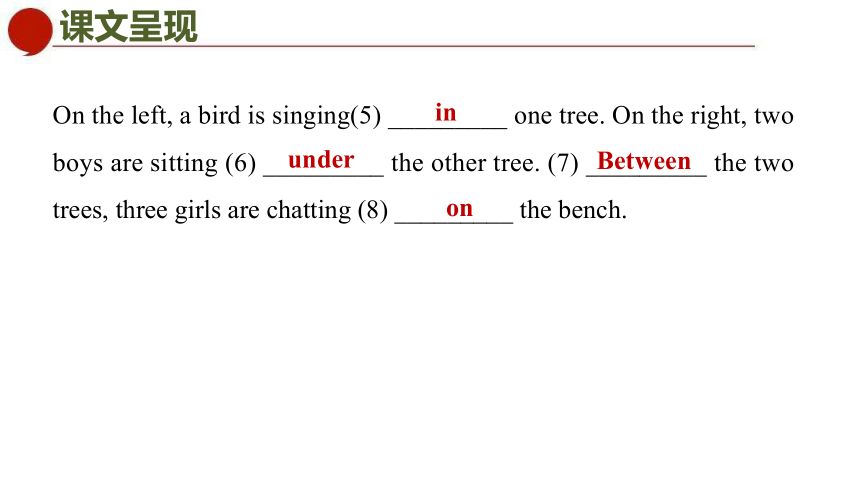
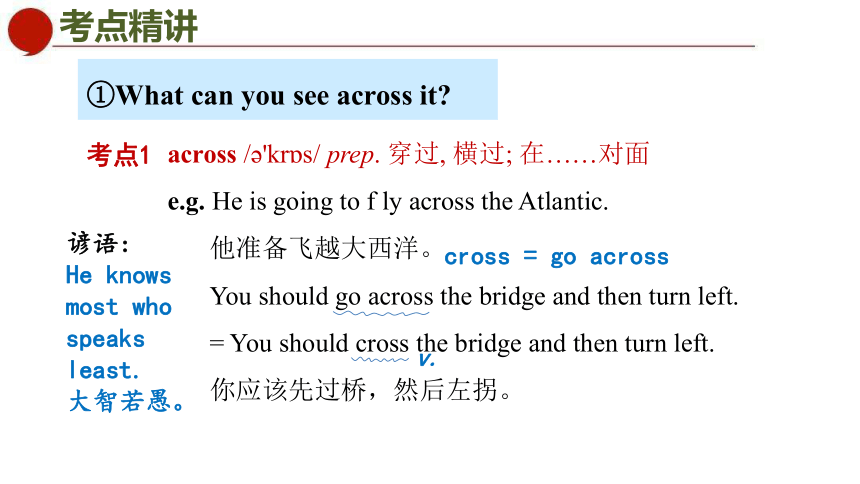
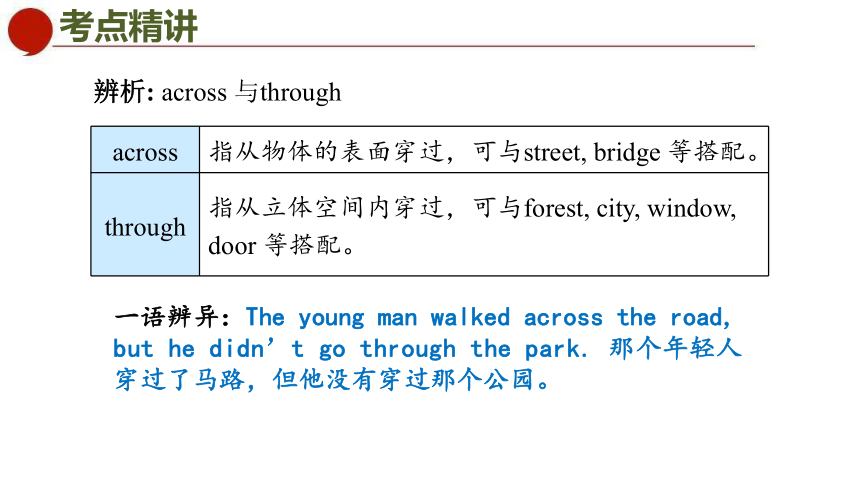
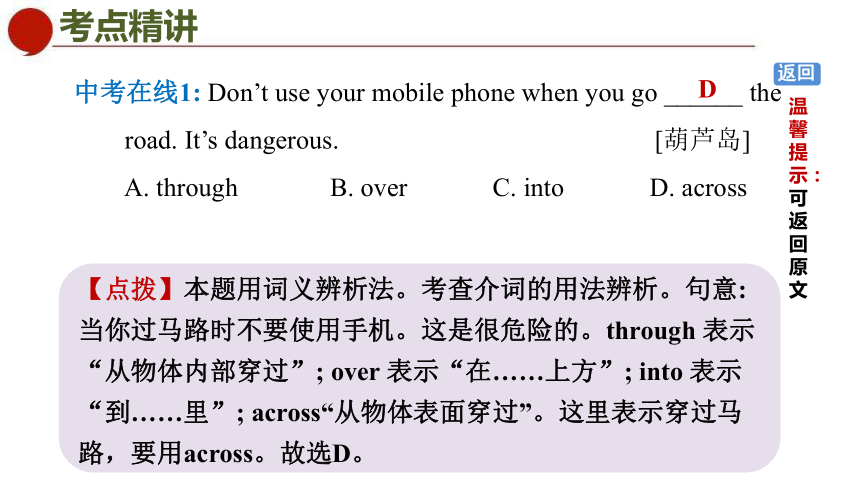
文档简介
(共71张PPT)
Period 3 Grammar
Unit 4 Finding your way
A. Using a, an and the
We use a or an when we mention a person or thing for the first time. We use the before a noun when the person or thing is mentioned again, or when we are talking about a specific person or thing.
Look! Here is a panda.
The panda is eating bamboo.
Fun in the zoo
Millie and Daniel are talking about the animals in the plete their conversation with a, an or the.
Millie: Let’s go to the Panda House first.
Daniel: Here we are. I can see (1) __________ panda there. It’s lying on the grass.
Millie: How cute! I really love pandas. Look! There’s (2) _________ baby panda. It’s so small.
a
a
Daniel: Yes. (3) _____________ baby panda doesn’t look like its mother.
Millie: Now let’s go to see some lions.
Daniel: Are (4) __________ lions in (5) __________ open area
Millie: No, they aren’t. They’re in (6) __________ very big cage.
Daniel: I see.
The
the
an
a
(Half an hour later)
Daniel: Millie, here’s (7) __________ bridge. What can you see across it ①
Millie: Oh, (8) __________ elephant is standing over there.
Daniel: Let’s go across (9) __________ bridge and see (10) __________ elephant.
a
温馨提示: 此符号表示“考点精讲点拨”链接。
an
the
the
B. Prepositions of place
We use prepositions of place to say where things or people are.
TIP
Prepositions of place
above at behind
below beside between
in in front of inside
next to on outside
over under
The flowers are in front of the shop.
The trees are behind the shop.
The shopkeeper is inside the shop.
The boy is outside the shop. ②
The food is above the drinks. ③
The drinks are below the food.
The sign is over the bench.
The dog is under the bench.
In the park
Sandy goes to the park every weekend. Look at the picture below and complete her description with the correct prepositions of place.
There’s a beautiful lake in the park. Look! Two boys are rowing a boat (1) _______ the lake. (2) _________________ the lake there’s a football field. Some boys are playing football (3) _________ it. (4) ________________ the football field, there are two trees.
on
Next to / Beside
on
In front of
On the left, a bird is singing(5) _________ one tree. On the right, two boys are sitting (6) _________ the other tree. (7) _________ the two trees, three girls are chatting (8) _________ the bench.
in
under
Between
on
①What can you see across it
across / 'kr s/ prep. 穿过, 横过; 在……对面
e.g. He is going to f ly across the Atlantic.
他准备飞越大西洋。
You should go across the bridge and then turn left.
= You should cross the bridge and then turn left.
你应该先过桥,然后左拐。
考点1
v.
cross = go across
谚语:
He knows most who speaks least.
大智若愚。
辨析: across 与through
across 指从物体的表面穿过,可与street, bridge 等搭配。
through 指从立体空间内穿过,可与forest, city, window, door 等搭配。
一语辨异:The young man walked across the road, but he didn’t go through the park. 那个年轻人穿过了马路,但他没有穿过那个公园。
中考在线1: Don’t use your mobile phone when you go ______ the road. It’s dangerous. [葫芦岛]
A. through B. over C. into D. across
D
【点拨】本题用词义辨析法。考查介词的用法辨析。句意: 当你过马路时不要使用手机。这是很危险的。through 表示“从物体内部穿过”; over 表示“在……上方”; into 表示“到……里”; across“从物体表面穿过”。这里表示穿过马路,要用across。故选D。
返回
温馨提示:可返回原文
②The boy is outside the shop.
outside / a t'sa d/ prep. 在……外面
e.g. Don’t stand outside the room.
不要站在房间外面。
His mother is waiting outside.
他的妈妈正在外面等着。
考点2
反义词是inside,意为“在……里面”
adv. 在外面
中考在线2: Simon, let’s meet ___________(在……外面) the theatre at 2 o’clock. [常州]
【点拨】根据汉语意思“在……外面”,所对应的单词是outside。
outside
返回
③The food is above the drinks.
above / 'b v/ prep. 在……上面
e.g. There is a map above the blackboard.
黑板的上方有一张地图。
考点3
其反义词为below“在……下面”。
考向
辨析: on, over 与above
on “在……之上”,物体与物体表面相接触,一件东西在另一件之上。
over 介词,表示在垂直正上方,不接触表面。
above 介词,其反义词是below。表示在上方或位置高出某物体,但不一定在垂直上方。
e.g. There is a book on the desk.
书桌上有一本书。
The lamp is over the table.
灯在桌子上方。
His office is above ours.
他的办公室在我们的上面。
中考在线3: The water came _________ (在……上面) our knees.
above
中考在线4: In cold winter, the temperature in Harbin often remains _______ zero all day.
A. above B. below C. over D. under
【点拨】below zero 在零度以下,属固定用法。
B
返回
不定冠词的用法
不定冠词有a 和an 两种形式, a 用于以辅音音素开头的单词前, an 用于以元音音素开头的单词前。其用法有:
考点1
冠词a/an/the
冠词分不定冠词a(an) 和定冠词the 两种。
用法 举例
泛指人或事物的某一类别, 以区别于其他种类。 A plane is a machine that can fly.
飞机是一种能飞的机器。
首次提到某个单数可数名词。 There’s a bird in the tree.
树上有只鸟。
表示“数量”, 但数的概念没有one 强烈。 I have a sister. 我有一个妹妹。
用于固定短语中。 a little(一点儿) ;
wait a minute(等一会儿)
速记小法:
不定冠词的用法(顺口溜):
冠词a, an 两种帽,许多名词都需要。
开头读音若是元,要把an 帽来挑选。
辅音开头戴a 帽,记住规律莫乱套。
中考在线1: I would like to be _______ scientist in the future. They are so great. [鸡西]
A. a B. an C. the
【点拨】本题用语法判定法。考查冠词的用法。句意: 未来我想成为一位科学家,他们真伟大。表示“一位科学家”,应用a scientist,因为scientist 以辅音音素开头,此处应用不定冠词a。故选A。
A
中考在线2: It took us half _____ hour to read Little Women.
[岳阳]
A. a B. an C. the
【点拨】本题用语法判定法。考查冠词的用法。句意: 阅读《小妇人》花费了我们半个小时的时间。hour以元音音素开头,用冠词an,half an hour 意为“半小时”。故选B。
B
定冠词的用法
考点2
用法 举例
特指某些人或物。 The children are coming.
孩子们就要来了。
用于上文提到过的事物
或双方都知道的事物。 Mr Li works in a factory. The factory is far from his home. 李先生在一家工厂上班, 那家工厂离他家很远。
用于世界上独一无二的
事物前。 The moon goes around the earth. 月亮绕着地球转。
用法 举例
用于序数词或形容词最高级前。 Who is the youngest girl in your class 谁是你们班最小的女孩?
用于姓氏复数名词前, 表示“……一家人或……夫妇”。 The Greens are going for a picnic next Sunday. 格林一家下个星期日打算去野餐。
用于乐器名称前或方位
名词之前。 play the guitar 弹吉他
用于固定搭配中。 in the morning 在上午;
at the end of 在……的尽头
速记小法:
定冠词the 的用法(顺口溜):
特指双方熟悉,上文已经提及;
世上独一无二,方位名词乐器;
某些专有名词,外加复数姓氏;
序数词最高级,习惯用语要特记。
中考在线3: I got a nice gift from my aunt and _______ gift was a souvenir(纪念品) from her study tour in England. [恩施]
A. 不填 B. a C. the
【点拨】本题用语法判定法。考查冠词的用法。句意: 我从我姑姑那儿得到了一件精美的礼物,这件礼物是她在英国研学时的纪念品。由句意可知句中第二次提到的这件礼物是特指来自姑姑的礼物,要用定冠词the,故选C。
C
中考在线4: Many more people have realized saving ______ earth begins with small things. [吉林]
A. a B. an C. the
【点拨】本题用语法判定法。考查冠词的用法。句意: 更多的人已经意识到拯救地球始于小事情。句中的earth “地球”,为世界上独一无二的事物,其前应加定冠词the。故选C。
C
不用冠词的情况:
考点3
用法 举例
不可数名词和复数名词
表泛指。 Vegetables are good for our health. 蔬菜有益于我们的健康。
人名、地名、(非缩写的) 国家名、物质名词、抽象名词前。 Mary comes from New York.
玛丽来自纽约。
用法 举例
可数名词前有物主代词、
指示代词、不定代词或
名词所有格等修饰。 Lily’s bedroom is bigger than mine. 莉莉的卧室比我的大。
某些节日、季节、月份、
星期、三餐、(与play
连用时的) 球类和棋类、
学科名词前。 March 8th is Women’s Day.
三月八号是妇女节。
用法 举例
称呼语或表示头衔的名
词前。 What’s the matter with you, Granny 你怎么了, 奶奶?
与by 连用的表示交通工具的名词前。 by car/bus/train/plane
乘坐小汽车/公共汽车/火车/飞机
用于固定短语。 on foot(步行) ; go to bed(去睡觉)
速记小法:
零冠词的用法(顺口溜):
下列情况不用冠, 名词之前代词限。
复数名词表泛指, 球类学科和三餐。
专有名词不可数, 星期月份季节前。
交通手段和节日, 习语称谓和头衔。
中考在线5: Jim started to play _______ chess when he was five. [武威改编]
A. a B. an C. the D. /
【点拨】本题用语法判定法。考查冠词的用法。句意:
吉姆五岁时开始下棋。动词play 后跟棋类名词时,名词前不用冠词。故选D。
D
中考在线6: Tom was happy to get a chance to play _______ football for the school team. [南通]
A. a B. an C. the D. 不填
【点拨】本题用语法判定法。考查冠词的用法。句意: 汤姆很高兴有机会为校队踢足球。football“足球”,play+ 球类运动时,球类运动名词之前不需要用冠词。故选D。
D
方位介词用来表示地点、方位和位移。介词是一种虚词, 不能单独使用, 它必须与后面的名词或代词结合构成介词短语在句中充当句子成分。方位介词短语常作句子的表语、状语和定语。
考点1
方位介词
用法点拨
1. 常用的方位介词可分为以下几组:
考点2
方位介词 意义用法
at, in at 的后面一般接小地点, 而in 的后面则接大地点。
between,
among between 一般指在两者之间, among 表示在三者或三者以上之间。
方位介词 意义用法
beside,
next to,
near beside 指“在…… 旁边”, next to表示“紧挨着, 紧靠着”, near“在……附近”。
above,
below,
over, under, on above 指“在……上方”, 反义词是below。over “在……正上方(垂直) ”。under“在……下方”。而on 指的是“在……(物体) 的上面”,指相互接触。
方位介词 意义用法
inside,
outside inside 指在……里面, 其反义词是 outside。
in front
of, behind in front of 意为“在……前面”,表示有一定距离的前面, 也可理解为在物体范围外的前面, 其反义词是behind。
e.g. I often stay at home at the weekend.
周末我常待在家里。
When will you arrive in Shanghai
你将什么时间到达上海
I sit between Daniel and Amy.
我坐在丹尼尔和埃米中间。
Look! Mr Li is standing among his students.
看! 李老师正站在他的学生中间。
Come and sit beside me. 过来坐在我的旁边。
The pretty girl is standing next to the window.
那个漂亮的女孩正站在窗户旁边。
Do you live near here 你住在这附近吗?
There’s a bridge over the river. 河上有座桥。
Shall I write my answer below or above the line
我应该把答案写在线下方还是线上方
There are some apples on the table. 桌上有些苹果。
Inside the box was a watch. 盒子里装着一块表。
When shall we meet outside the school
我们什么时间在校外见面
There’s a park in front of the house.
在那所房子的前面有一个公园。
Who sits behind you 谁坐在你后面
中考在线7: When are you arriving I’ll pick you up _______ the station. [河北]
A. at B. to C. on D. off
【点拨】本题用词语运用法。句意: 你什么时候到达?我将在车站接你。at the station 意为“在车站”。故选A。
A
2. 方位介词短语的功能 ①作表语
作表语时, 介词短语常位于系动词(主要是be动词) 之后, 用来说明主语的方位。
e.g. We are in the classroom. 我们在教室里。
The big tree is in front of the house.
那棵大树在房子的前面。
对作表语的方位介词短语提问时要用where。
e.g. The bike is behind the tree.
那辆自行车在树的后面。
提问:
Where is the bike 自行车在哪里
②作状语
作状语时, 介词短语可放在句首或句末, 用来表示主语动作发生的地点。
e.g. The girls are singing under the tree.
女孩子们正在树下唱歌。
对作状语的方位介词短语提问要用where。
e.g. We often read in the reading room.
我们经常在阅览室读书。
提问:
Where do you often read
你们经常在哪里读书
③作定语
方位介词短语还可放在名词后, 限定、修饰名词,作名词的后置定语。
e.g. The boy in front of Millie is my brother.
米莉前面的男孩是我弟弟。
对作定语的方位介词短语提问时要用which, 后接方位介词短语所修饰的名词。
e.g. The girl next to me is Sandy.
我旁边的女孩是桑迪。
提问:
Which girl is Sandy
哪个女孩是桑迪?
中考在线8: The little boy hid himself _______ the door to give his sister a surprise. [盘锦]
A. behind B. above C. across D. under
【点拨】考查介词辨析。句意: 小男孩藏在门后_____ 想给他妹妹一个惊喜。behind 在……后面; above 在……上面; across 在……对面; under在…… 下面。根据“to give his sister a surprise为了给他妹妹一个惊喜”可推知是藏在门后面,behind 符合语境。故选A。
A
1. What ______ pity that you couldn’t go to the party! [武威]
A. a B. an C. the D. /
单项选择
A
【点拨】本题用固定搭配法。考查冠词的用法。“What a pity...!”是固定用法,意为“……真可惜!”,故选A。
2. Look, there are so many stars in ______ sky. [重庆A 卷]
A. a B. an C. the D. /
【点拨】本题用语法判定法。 考查冠词的用法。句意: 看,天空中有如此多的星星。sky是世上独一无二的事物,其前要用定冠词the。故选C。
C
3. It is good to eat ______ apple every day. [桂林]
A. the B. an C. a
【点拨】本题用语法判定法。考查冠词的用法。句意: 每天吃一个苹果有好处。由句意可知,这里泛指“一个苹果”,排除A; apple是以元音音素开头的名词,其前应用不定冠词an修饰。故选B。
B
4. The Tianwen Ⅰ probe(探测器) sent ______ first picture of Mars back to China in February, 2021. [岳阳]
A. a B. an C. the
【点拨】本题用语法判定法。考查冠词的用法。句意: 天问一号探测器于2021年2月向中国发回了第一张火星的照片。序数词之前要用定冠词。故选C。
C
5. Among all traditional Chinese arts, Nancy likes ______ Beijing opera best because it is great ______ fun. [泰州]
A. /; a B. /; /
C. the; a D. the; /
B
6. Bruce likes playing ______ soccer, so his father bought him ______ soccer ball. [凉山]
A. a; an B. the; a
C. /; the D. /; a
【点拨】本题用语法判定法。考查冠词的用法。play与球类名词搭配时,球类前不加冠词; 后面提到给他买了一个足球,表示泛指“一个”用不定冠词a, 故选D。
D
7. —Look, who’s ______ woman in red
—She’s my new English teacher with ______ eight-year-old daughter. [自贡]
A. the; a B. a; an C. the; an
【点拨】本题用语法判定法。考查冠词的用法。句意: —看,穿红衣服的那个妇女是谁?—她是我的新英语老师,带着一个8岁的女儿。第一空有in red修饰,表特指,用定冠词the; 第二空表示“泛指”,有数量“一”的意思,用不定冠词。因eight的开头为元音音素[e ],因此用an。故选C。
C
8. —How long does it take us to go to your hometown from here
—It takes us ______ hour to go to my hometown by ______ train.
[齐齐哈尔]
A. an; a B. an; / C. an; the
B
9. I like playing ______ chess but my brother likes playing ______ piano. [怀化]
A. the; the B. the; / C. / ; the
【点拨】本题用语法判定法。考查冠词的用法。句意: 我喜欢下棋但是我弟弟喜欢弹钢琴。棋牌类名词前不用冠词; 乐器名词前必须加定冠词the。故选C。
C
10. ______ Greens are preparing for the coming Thanksgiving Day.
[广东]
A. / B. A C. An D. The
【点拨】the+姓氏复数表示“……一家人”,故选D。
D
11. We planted some flowers ______ the garden yesterday.
[北京]
A. on B. to C. in D. of
【点拨】考查介词的用法。句意: 昨天我们在花园里种了一些花。在花园里用介词in。故选C。
C
12. Nora opened the box. To her surprise, ______ it was a gold watch.
[苏州]
A. outside B. inside C. beside D. behind
【点拨】句意: 诺拉打开了盒子,令她惊奇的是,在它里面是一块金表。表示“在……里面”应用inside。故选B。
B
13. —We’d better not read ______ the sun.
—I agree. It’s bad for our eyes. [泉州]
A. in B. with C. under
【点拨】考查固定词组in the sun,意为“在阳光下”,故选A。
A
14. Jim sits behind me, so I sit ______ him.
A. under B. in front of
C. in the front of D. beside
B
15. —Is your father at home
—No, he’s working late ______ the office.
A. on B. at C. of D. to
【点拨】本题用词语应用法。在办公室用介词at。故选B。
B
16. —Where’s the People’s Park
—Go along Gongyuan Road, turn right at the second crossing and it’s ______ your left. [十堰]
A. on B. to C. at D. in
【点拨】考查介词的用法。句意: —人民公园在哪儿?—沿着公园路走,在第二个十字路口右转,它就在你的左边。on one’s left“在某人的左边”,为固定短语。故选A。
A
17. To my great joy, my family is always ______ me whatever I decide to do. [孝感]
A. behind B. to C. from D. against
【点拨】考查介词辨析。句意: 使我非常高兴的是,无论我决定做什么,我的家人总是支持我。behind在……的后面,支持; to到,对着,朝向; from从; against倚靠,反对。由句意可知选A。
A
18. Cambridge is a small city ______ the east of England. [天津]
A. between B. with C. in D. under
【点拨】在某一范围内的某个方位用介词in。
C
19. I can’t see Lucy because she is ______ the tree. [成都改编]
A. in front of B. behind
C. next to D. beside
【点拨】句意: 我看不见露西,因为她在树的后面。由can’t see可知用介词behind,意为“在……的后面”。
B
20. Walk ______ this street, and turn right ______ the second crossing. Then you’ll find the bank.
A. past; on B. along; at
C. cross; to D. to; to
【点拨】walk along意为“沿着……走”; 在十字路口用介词at。
B
本节课主要学习了以下知识点,请同学们及时巩固练习:
across , inside , outside , above , lie on the grass……
Period 3 Grammar
Unit 4 Finding your way
A. Using a, an and the
We use a or an when we mention a person or thing for the first time. We use the before a noun when the person or thing is mentioned again, or when we are talking about a specific person or thing.
Look! Here is a panda.
The panda is eating bamboo.
Fun in the zoo
Millie and Daniel are talking about the animals in the plete their conversation with a, an or the.
Millie: Let’s go to the Panda House first.
Daniel: Here we are. I can see (1) __________ panda there. It’s lying on the grass.
Millie: How cute! I really love pandas. Look! There’s (2) _________ baby panda. It’s so small.
a
a
Daniel: Yes. (3) _____________ baby panda doesn’t look like its mother.
Millie: Now let’s go to see some lions.
Daniel: Are (4) __________ lions in (5) __________ open area
Millie: No, they aren’t. They’re in (6) __________ very big cage.
Daniel: I see.
The
the
an
a
(Half an hour later)
Daniel: Millie, here’s (7) __________ bridge. What can you see across it ①
Millie: Oh, (8) __________ elephant is standing over there.
Daniel: Let’s go across (9) __________ bridge and see (10) __________ elephant.
a
温馨提示: 此符号表示“考点精讲点拨”链接。
an
the
the
B. Prepositions of place
We use prepositions of place to say where things or people are.
TIP
Prepositions of place
above at behind
below beside between
in in front of inside
next to on outside
over under
The flowers are in front of the shop.
The trees are behind the shop.
The shopkeeper is inside the shop.
The boy is outside the shop. ②
The food is above the drinks. ③
The drinks are below the food.
The sign is over the bench.
The dog is under the bench.
In the park
Sandy goes to the park every weekend. Look at the picture below and complete her description with the correct prepositions of place.
There’s a beautiful lake in the park. Look! Two boys are rowing a boat (1) _______ the lake. (2) _________________ the lake there’s a football field. Some boys are playing football (3) _________ it. (4) ________________ the football field, there are two trees.
on
Next to / Beside
on
In front of
On the left, a bird is singing(5) _________ one tree. On the right, two boys are sitting (6) _________ the other tree. (7) _________ the two trees, three girls are chatting (8) _________ the bench.
in
under
Between
on
①What can you see across it
across / 'kr s/ prep. 穿过, 横过; 在……对面
e.g. He is going to f ly across the Atlantic.
他准备飞越大西洋。
You should go across the bridge and then turn left.
= You should cross the bridge and then turn left.
你应该先过桥,然后左拐。
考点1
v.
cross = go across
谚语:
He knows most who speaks least.
大智若愚。
辨析: across 与through
across 指从物体的表面穿过,可与street, bridge 等搭配。
through 指从立体空间内穿过,可与forest, city, window, door 等搭配。
一语辨异:The young man walked across the road, but he didn’t go through the park. 那个年轻人穿过了马路,但他没有穿过那个公园。
中考在线1: Don’t use your mobile phone when you go ______ the road. It’s dangerous. [葫芦岛]
A. through B. over C. into D. across
D
【点拨】本题用词义辨析法。考查介词的用法辨析。句意: 当你过马路时不要使用手机。这是很危险的。through 表示“从物体内部穿过”; over 表示“在……上方”; into 表示“到……里”; across“从物体表面穿过”。这里表示穿过马路,要用across。故选D。
返回
温馨提示:可返回原文
②The boy is outside the shop.
outside / a t'sa d/ prep. 在……外面
e.g. Don’t stand outside the room.
不要站在房间外面。
His mother is waiting outside.
他的妈妈正在外面等着。
考点2
反义词是inside,意为“在……里面”
adv. 在外面
中考在线2: Simon, let’s meet ___________(在……外面) the theatre at 2 o’clock. [常州]
【点拨】根据汉语意思“在……外面”,所对应的单词是outside。
outside
返回
③The food is above the drinks.
above / 'b v/ prep. 在……上面
e.g. There is a map above the blackboard.
黑板的上方有一张地图。
考点3
其反义词为below“在……下面”。
考向
辨析: on, over 与above
on “在……之上”,物体与物体表面相接触,一件东西在另一件之上。
over 介词,表示在垂直正上方,不接触表面。
above 介词,其反义词是below。表示在上方或位置高出某物体,但不一定在垂直上方。
e.g. There is a book on the desk.
书桌上有一本书。
The lamp is over the table.
灯在桌子上方。
His office is above ours.
他的办公室在我们的上面。
中考在线3: The water came _________ (在……上面) our knees.
above
中考在线4: In cold winter, the temperature in Harbin often remains _______ zero all day.
A. above B. below C. over D. under
【点拨】below zero 在零度以下,属固定用法。
B
返回
不定冠词的用法
不定冠词有a 和an 两种形式, a 用于以辅音音素开头的单词前, an 用于以元音音素开头的单词前。其用法有:
考点1
冠词a/an/the
冠词分不定冠词a(an) 和定冠词the 两种。
用法 举例
泛指人或事物的某一类别, 以区别于其他种类。 A plane is a machine that can fly.
飞机是一种能飞的机器。
首次提到某个单数可数名词。 There’s a bird in the tree.
树上有只鸟。
表示“数量”, 但数的概念没有one 强烈。 I have a sister. 我有一个妹妹。
用于固定短语中。 a little(一点儿) ;
wait a minute(等一会儿)
速记小法:
不定冠词的用法(顺口溜):
冠词a, an 两种帽,许多名词都需要。
开头读音若是元,要把an 帽来挑选。
辅音开头戴a 帽,记住规律莫乱套。
中考在线1: I would like to be _______ scientist in the future. They are so great. [鸡西]
A. a B. an C. the
【点拨】本题用语法判定法。考查冠词的用法。句意: 未来我想成为一位科学家,他们真伟大。表示“一位科学家”,应用a scientist,因为scientist 以辅音音素开头,此处应用不定冠词a。故选A。
A
中考在线2: It took us half _____ hour to read Little Women.
[岳阳]
A. a B. an C. the
【点拨】本题用语法判定法。考查冠词的用法。句意: 阅读《小妇人》花费了我们半个小时的时间。hour以元音音素开头,用冠词an,half an hour 意为“半小时”。故选B。
B
定冠词的用法
考点2
用法 举例
特指某些人或物。 The children are coming.
孩子们就要来了。
用于上文提到过的事物
或双方都知道的事物。 Mr Li works in a factory. The factory is far from his home. 李先生在一家工厂上班, 那家工厂离他家很远。
用于世界上独一无二的
事物前。 The moon goes around the earth. 月亮绕着地球转。
用法 举例
用于序数词或形容词最高级前。 Who is the youngest girl in your class 谁是你们班最小的女孩?
用于姓氏复数名词前, 表示“……一家人或……夫妇”。 The Greens are going for a picnic next Sunday. 格林一家下个星期日打算去野餐。
用于乐器名称前或方位
名词之前。 play the guitar 弹吉他
用于固定搭配中。 in the morning 在上午;
at the end of 在……的尽头
速记小法:
定冠词the 的用法(顺口溜):
特指双方熟悉,上文已经提及;
世上独一无二,方位名词乐器;
某些专有名词,外加复数姓氏;
序数词最高级,习惯用语要特记。
中考在线3: I got a nice gift from my aunt and _______ gift was a souvenir(纪念品) from her study tour in England. [恩施]
A. 不填 B. a C. the
【点拨】本题用语法判定法。考查冠词的用法。句意: 我从我姑姑那儿得到了一件精美的礼物,这件礼物是她在英国研学时的纪念品。由句意可知句中第二次提到的这件礼物是特指来自姑姑的礼物,要用定冠词the,故选C。
C
中考在线4: Many more people have realized saving ______ earth begins with small things. [吉林]
A. a B. an C. the
【点拨】本题用语法判定法。考查冠词的用法。句意: 更多的人已经意识到拯救地球始于小事情。句中的earth “地球”,为世界上独一无二的事物,其前应加定冠词the。故选C。
C
不用冠词的情况:
考点3
用法 举例
不可数名词和复数名词
表泛指。 Vegetables are good for our health. 蔬菜有益于我们的健康。
人名、地名、(非缩写的) 国家名、物质名词、抽象名词前。 Mary comes from New York.
玛丽来自纽约。
用法 举例
可数名词前有物主代词、
指示代词、不定代词或
名词所有格等修饰。 Lily’s bedroom is bigger than mine. 莉莉的卧室比我的大。
某些节日、季节、月份、
星期、三餐、(与play
连用时的) 球类和棋类、
学科名词前。 March 8th is Women’s Day.
三月八号是妇女节。
用法 举例
称呼语或表示头衔的名
词前。 What’s the matter with you, Granny 你怎么了, 奶奶?
与by 连用的表示交通工具的名词前。 by car/bus/train/plane
乘坐小汽车/公共汽车/火车/飞机
用于固定短语。 on foot(步行) ; go to bed(去睡觉)
速记小法:
零冠词的用法(顺口溜):
下列情况不用冠, 名词之前代词限。
复数名词表泛指, 球类学科和三餐。
专有名词不可数, 星期月份季节前。
交通手段和节日, 习语称谓和头衔。
中考在线5: Jim started to play _______ chess when he was five. [武威改编]
A. a B. an C. the D. /
【点拨】本题用语法判定法。考查冠词的用法。句意:
吉姆五岁时开始下棋。动词play 后跟棋类名词时,名词前不用冠词。故选D。
D
中考在线6: Tom was happy to get a chance to play _______ football for the school team. [南通]
A. a B. an C. the D. 不填
【点拨】本题用语法判定法。考查冠词的用法。句意: 汤姆很高兴有机会为校队踢足球。football“足球”,play+ 球类运动时,球类运动名词之前不需要用冠词。故选D。
D
方位介词用来表示地点、方位和位移。介词是一种虚词, 不能单独使用, 它必须与后面的名词或代词结合构成介词短语在句中充当句子成分。方位介词短语常作句子的表语、状语和定语。
考点1
方位介词
用法点拨
1. 常用的方位介词可分为以下几组:
考点2
方位介词 意义用法
at, in at 的后面一般接小地点, 而in 的后面则接大地点。
between,
among between 一般指在两者之间, among 表示在三者或三者以上之间。
方位介词 意义用法
beside,
next to,
near beside 指“在…… 旁边”, next to表示“紧挨着, 紧靠着”, near“在……附近”。
above,
below,
over, under, on above 指“在……上方”, 反义词是below。over “在……正上方(垂直) ”。under“在……下方”。而on 指的是“在……(物体) 的上面”,指相互接触。
方位介词 意义用法
inside,
outside inside 指在……里面, 其反义词是 outside。
in front
of, behind in front of 意为“在……前面”,表示有一定距离的前面, 也可理解为在物体范围外的前面, 其反义词是behind。
e.g. I often stay at home at the weekend.
周末我常待在家里。
When will you arrive in Shanghai
你将什么时间到达上海
I sit between Daniel and Amy.
我坐在丹尼尔和埃米中间。
Look! Mr Li is standing among his students.
看! 李老师正站在他的学生中间。
Come and sit beside me. 过来坐在我的旁边。
The pretty girl is standing next to the window.
那个漂亮的女孩正站在窗户旁边。
Do you live near here 你住在这附近吗?
There’s a bridge over the river. 河上有座桥。
Shall I write my answer below or above the line
我应该把答案写在线下方还是线上方
There are some apples on the table. 桌上有些苹果。
Inside the box was a watch. 盒子里装着一块表。
When shall we meet outside the school
我们什么时间在校外见面
There’s a park in front of the house.
在那所房子的前面有一个公园。
Who sits behind you 谁坐在你后面
中考在线7: When are you arriving I’ll pick you up _______ the station. [河北]
A. at B. to C. on D. off
【点拨】本题用词语运用法。句意: 你什么时候到达?我将在车站接你。at the station 意为“在车站”。故选A。
A
2. 方位介词短语的功能 ①作表语
作表语时, 介词短语常位于系动词(主要是be动词) 之后, 用来说明主语的方位。
e.g. We are in the classroom. 我们在教室里。
The big tree is in front of the house.
那棵大树在房子的前面。
对作表语的方位介词短语提问时要用where。
e.g. The bike is behind the tree.
那辆自行车在树的后面。
提问:
Where is the bike 自行车在哪里
②作状语
作状语时, 介词短语可放在句首或句末, 用来表示主语动作发生的地点。
e.g. The girls are singing under the tree.
女孩子们正在树下唱歌。
对作状语的方位介词短语提问要用where。
e.g. We often read in the reading room.
我们经常在阅览室读书。
提问:
Where do you often read
你们经常在哪里读书
③作定语
方位介词短语还可放在名词后, 限定、修饰名词,作名词的后置定语。
e.g. The boy in front of Millie is my brother.
米莉前面的男孩是我弟弟。
对作定语的方位介词短语提问时要用which, 后接方位介词短语所修饰的名词。
e.g. The girl next to me is Sandy.
我旁边的女孩是桑迪。
提问:
Which girl is Sandy
哪个女孩是桑迪?
中考在线8: The little boy hid himself _______ the door to give his sister a surprise. [盘锦]
A. behind B. above C. across D. under
【点拨】考查介词辨析。句意: 小男孩藏在门后_____ 想给他妹妹一个惊喜。behind 在……后面; above 在……上面; across 在……对面; under在…… 下面。根据“to give his sister a surprise为了给他妹妹一个惊喜”可推知是藏在门后面,behind 符合语境。故选A。
A
1. What ______ pity that you couldn’t go to the party! [武威]
A. a B. an C. the D. /
单项选择
A
【点拨】本题用固定搭配法。考查冠词的用法。“What a pity...!”是固定用法,意为“……真可惜!”,故选A。
2. Look, there are so many stars in ______ sky. [重庆A 卷]
A. a B. an C. the D. /
【点拨】本题用语法判定法。 考查冠词的用法。句意: 看,天空中有如此多的星星。sky是世上独一无二的事物,其前要用定冠词the。故选C。
C
3. It is good to eat ______ apple every day. [桂林]
A. the B. an C. a
【点拨】本题用语法判定法。考查冠词的用法。句意: 每天吃一个苹果有好处。由句意可知,这里泛指“一个苹果”,排除A; apple是以元音音素开头的名词,其前应用不定冠词an修饰。故选B。
B
4. The Tianwen Ⅰ probe(探测器) sent ______ first picture of Mars back to China in February, 2021. [岳阳]
A. a B. an C. the
【点拨】本题用语法判定法。考查冠词的用法。句意: 天问一号探测器于2021年2月向中国发回了第一张火星的照片。序数词之前要用定冠词。故选C。
C
5. Among all traditional Chinese arts, Nancy likes ______ Beijing opera best because it is great ______ fun. [泰州]
A. /; a B. /; /
C. the; a D. the; /
B
6. Bruce likes playing ______ soccer, so his father bought him ______ soccer ball. [凉山]
A. a; an B. the; a
C. /; the D. /; a
【点拨】本题用语法判定法。考查冠词的用法。play与球类名词搭配时,球类前不加冠词; 后面提到给他买了一个足球,表示泛指“一个”用不定冠词a, 故选D。
D
7. —Look, who’s ______ woman in red
—She’s my new English teacher with ______ eight-year-old daughter. [自贡]
A. the; a B. a; an C. the; an
【点拨】本题用语法判定法。考查冠词的用法。句意: —看,穿红衣服的那个妇女是谁?—她是我的新英语老师,带着一个8岁的女儿。第一空有in red修饰,表特指,用定冠词the; 第二空表示“泛指”,有数量“一”的意思,用不定冠词。因eight的开头为元音音素[e ],因此用an。故选C。
C
8. —How long does it take us to go to your hometown from here
—It takes us ______ hour to go to my hometown by ______ train.
[齐齐哈尔]
A. an; a B. an; / C. an; the
B
9. I like playing ______ chess but my brother likes playing ______ piano. [怀化]
A. the; the B. the; / C. / ; the
【点拨】本题用语法判定法。考查冠词的用法。句意: 我喜欢下棋但是我弟弟喜欢弹钢琴。棋牌类名词前不用冠词; 乐器名词前必须加定冠词the。故选C。
C
10. ______ Greens are preparing for the coming Thanksgiving Day.
[广东]
A. / B. A C. An D. The
【点拨】the+姓氏复数表示“……一家人”,故选D。
D
11. We planted some flowers ______ the garden yesterday.
[北京]
A. on B. to C. in D. of
【点拨】考查介词的用法。句意: 昨天我们在花园里种了一些花。在花园里用介词in。故选C。
C
12. Nora opened the box. To her surprise, ______ it was a gold watch.
[苏州]
A. outside B. inside C. beside D. behind
【点拨】句意: 诺拉打开了盒子,令她惊奇的是,在它里面是一块金表。表示“在……里面”应用inside。故选B。
B
13. —We’d better not read ______ the sun.
—I agree. It’s bad for our eyes. [泉州]
A. in B. with C. under
【点拨】考查固定词组in the sun,意为“在阳光下”,故选A。
A
14. Jim sits behind me, so I sit ______ him.
A. under B. in front of
C. in the front of D. beside
B
15. —Is your father at home
—No, he’s working late ______ the office.
A. on B. at C. of D. to
【点拨】本题用词语应用法。在办公室用介词at。故选B。
B
16. —Where’s the People’s Park
—Go along Gongyuan Road, turn right at the second crossing and it’s ______ your left. [十堰]
A. on B. to C. at D. in
【点拨】考查介词的用法。句意: —人民公园在哪儿?—沿着公园路走,在第二个十字路口右转,它就在你的左边。on one’s left“在某人的左边”,为固定短语。故选A。
A
17. To my great joy, my family is always ______ me whatever I decide to do. [孝感]
A. behind B. to C. from D. against
【点拨】考查介词辨析。句意: 使我非常高兴的是,无论我决定做什么,我的家人总是支持我。behind在……的后面,支持; to到,对着,朝向; from从; against倚靠,反对。由句意可知选A。
A
18. Cambridge is a small city ______ the east of England. [天津]
A. between B. with C. in D. under
【点拨】在某一范围内的某个方位用介词in。
C
19. I can’t see Lucy because she is ______ the tree. [成都改编]
A. in front of B. behind
C. next to D. beside
【点拨】句意: 我看不见露西,因为她在树的后面。由can’t see可知用介词behind,意为“在……的后面”。
B
20. Walk ______ this street, and turn right ______ the second crossing. Then you’ll find the bank.
A. past; on B. along; at
C. cross; to D. to; to
【点拨】walk along意为“沿着……走”; 在十字路口用介词at。
B
本节课主要学习了以下知识点,请同学们及时巩固练习:
across , inside , outside , above , lie on the grass……
